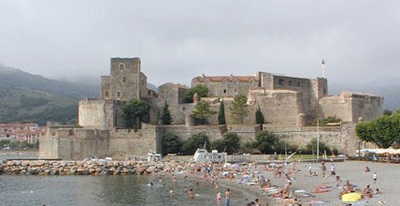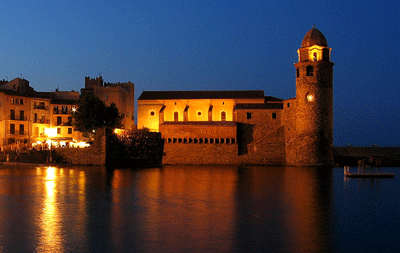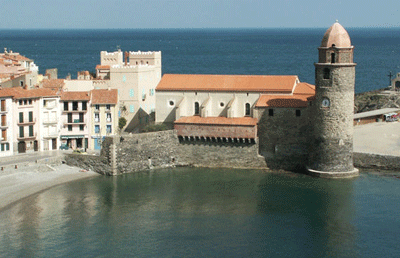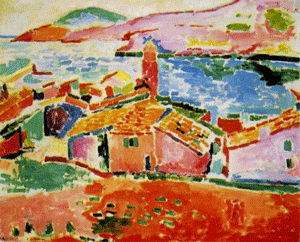 Collioure is a port on the Mediterranean
Sea a few kilometers north of the Spanish border in
the French département
of the Pyrénées-Orientales, corresponding
to the ancient Roussillon
and part of the present-day Languedoc-Roussillon
région. It lies on the Côte Vermeille, part
of the Gulf of Lyon.
Collioure is a port on the Mediterranean
Sea a few kilometers north of the Spanish border in
the French département
of the Pyrénées-Orientales, corresponding
to the ancient Roussillon
and part of the present-day Languedoc-Roussillon
région. It lies on the Côte Vermeille, part
of the Gulf of Lyon.
It is an atractive port with anunusually large number of art galleries.

![]() In
the XIIth century it was part of the Kindom of Majorca,
along with the rest of the Roussillon. There
is still a spectacular Royal Palace here. It
was later taken over by the Kings of Aragon, who had originally
created the Kingdom of Majorca.
In
the XIIth century it was part of the Kindom of Majorca,
along with the rest of the Roussillon. There
is still a spectacular Royal Palace here. It
was later taken over by the Kings of Aragon, who had originally
created the Kingdom of Majorca.
Collioure was once two villages separate villages, divided by the Douy river. The old town was named Port d'Aval (today known as Le Faubourg) in the south and the upstream port, Port d'Amont (now called La Ville).

![]() The
town was taken by the French troops under Maréchal
de la Meilleraye in 1642. A decade later, the town was formally
surrendered to France by the 1659 Treaty
of the Pyrenees. Because of its strategic importance,
the town's fortifications, including the Fort Saint-Elme,
were improved by the military engineer de
Vauban during the reign of Louis XIV, part of a vast
network of fortifications protecting the new Spanish border.
The bay, sandwiched between two small fishing ports,
is dominated by a fortress built by de
Vauban.
The
town was taken by the French troops under Maréchal
de la Meilleraye in 1642. A decade later, the town was formally
surrendered to France by the 1659 Treaty
of the Pyrenees. Because of its strategic importance,
the town's fortifications, including the Fort Saint-Elme,
were improved by the military engineer de
Vauban during the reign of Louis XIV, part of a vast
network of fortifications protecting the new Spanish border.
The bay, sandwiched between two small fishing ports,
is dominated by a fortress built by de
Vauban.
Collioure was besieged and occupied by Spanish troops in 1793 - to date the last Spanish attempt to recover the city. It was retaken by the French a year later under general Jacques François Dugommier.

![]() In
the early 1900s Collioure became a centre of artistic activity,
with several Fauvist artists selecting it as their favourite
place to paint. Other artists were attracted too. Among
them were André Derain, Georges Braque, Othon Friesz,
Henri Matisse, Pablo Picasso, Charles Rennie Mackintosh,
Tsuguharu Fujita and Salvadore Dali.
In
the early 1900s Collioure became a centre of artistic activity,
with several Fauvist artists selecting it as their favourite
place to paint. Other artists were attracted too. Among
them were André Derain, Georges Braque, Othon Friesz,
Henri Matisse, Pablo Picasso, Charles Rennie Mackintosh,
Tsuguharu Fujita and Salvadore Dali.
Collioure became the home of the Fauvist Mouvement because of the rare quality of the light. As Matisse, said "No sky in all France is more blue than that of Collioure". Since 1994 ”Le chemin du Fauvisme” has used the works of Matisse and Derain to illustrate 20 th century art in this small Catalan harbour. Copies of 20 works from Matisse and Derain are placed around the town at the spots from which the originals were painted, allowing viewers to compare the painting to the present view. The town is still popular with artists. Shame about the pink suburbs and numbers of tourists in high season.
Visit the bar of Les Templiers to see original works on the walls - that's how the artists paid their driniks bills. Website: http://www.collioure.com Art lovers can combine a trip here with one to the Picasso Museum in neary Céret.
|
Some things to visit:
|
|
|
Collioure is also the name of an AOC wine similar to the more famous Banyuls. The town has a strong Catalan culture. Its motto is the same as that of the local Catalan rugby team (Sempre endavant, mai morirem) - Always Forward, We'll Never Die.
|
|
 Art
lovers may wish to visit another Roussillon town with a
strong artistic history. Cubists such as Picasso, Bracque
and Gris, along with Matisse, Chagall, and Dali, favoured
the nearby town of Céret
Art
lovers may wish to visit another Roussillon town with a
strong artistic history. Cubists such as Picasso, Bracque
and Gris, along with Matisse, Chagall, and Dali, favoured
the nearby town of Céret
![]()
Collioure Photo Gallery









